Have you noticed any changes to the surface of your concrete products and are wondering what they are? Don’t worry, whether they are installed on the ground or on the siding of your home, it is normal for some changes to occur like stains. It is important to note that certain changes are also preventable. In this post, discover what exactly the changes are to the surface of your concrete products and how to prevent those changes to keep your project looking beautiful in the long term!
Efflorescence
Efflorescence is a natural phenomenon that is not the fault of the landscaper or the manufacturer. It appears most commonly after a new construction project is completed.
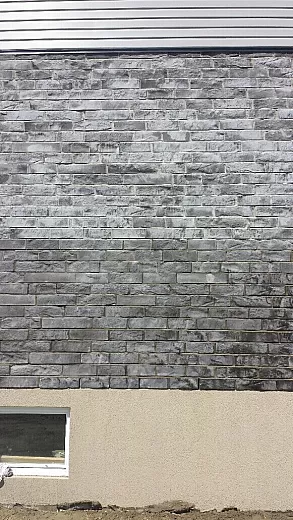
In summary, efflorescence is the migration of mineral salts(lime), causing a white residue, on the surface of the product. It can take up to 5 years for the mineral salts to wash away or become eliminated. Installation of the product during the cold weather months, primarily December to February, can provoke the appearance of efflorescence. If possible, avoid installing during the winter, when the weather is very cold.
There are many products on the market that can clean and help remove efflorescence. At Rinox, we recommend Polyblind products that can be found at your local hardware store. We suggest waiting up to a year after the product is installed before applying a cleaner since efflorescence can dissipate naturally with time.
Cement stains
Cement stains appear due to the mortar joint installation. Be sure to ask the professional stone or bricklayer to properly clean and brush the product when they have finished installing it. This can help remove any excess mortar joint cement that may have spilled onto the surface of the product.
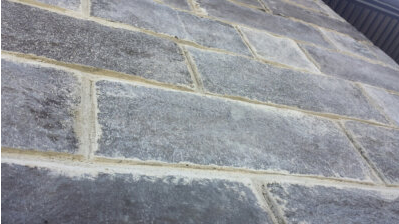
To prevent cement stains, it is important to determine the color of the mortar joint with your mason or landscaper before the installation.
Pro tip : Choose a mortar joint color similar to the color of your concrete product! Mortar joints that are contrasting with the color of the stone, tend to enhance the cement stain and therefore create a less clean looking finished product.
Cracks
If you see a crack on the stone once the installation is complete, make sure the crack does not exceed a ratio of 1/8 inch by 33 feet in wall length. A stone crack shouldn’t be visible at more than 20 feet from the home. In this case, it is a crack resulting from normal shrinkage.
The most at risk places for a crack to occur is under a window and around a door. Cracks that form a straight line are the result of the natural movement of a home settling into the soil.
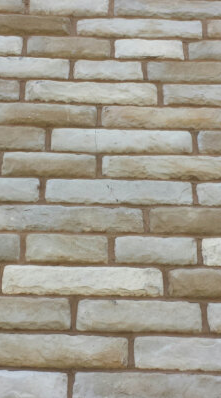
Humidity stains
This phenomenon is natural for raw materials like sand, stone and cement. In general, humidity stains most often appear on light colored stones. In Rinox’s stone collection, the following colors can be more at risk: Chablis, Amaretto and Almond White. When white cement becomes humid or wet, a greyish color can appear at the surface of the stone. Note: it can take up to a month for the stains to start naturally disappearing.
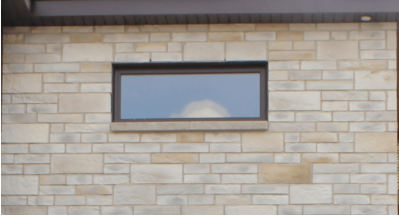
Rust
If you notice dark orange marks on your stone or pavers, this is a rust stain. This type of stain can appear from many different sources like the gutter drain, a car and grass fertilizer. There are several products on the market to reduce or remove rust stains. For a natural method, you can try using a very thin sandpaper. Moisten the rust stain and use the sandpaper by making small rotary movements until the stain starts to disappear. Then, rinse the surface with water! Note that the color of the product may be affected but will disappear with time.
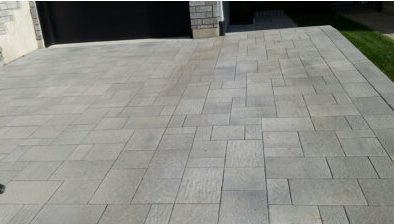
Cutting dust
When installing stones, slabs or pavers, concrete cutting generates dust. This cement dust can stick to the surface of the concrete products. To remove it, simply clean with water using a pressure washing machine.
Pro tip: Be careful when using the pressure washing machine… Do not pressure wash too close to the pavers as the force can cause the sand in the joints to vanish.
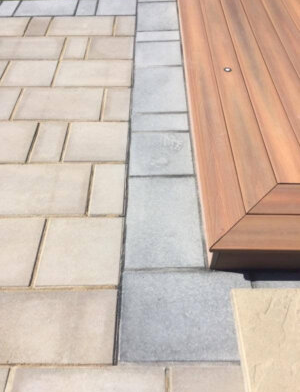
In general, the installation of concrete products is an easy and smooth process if the proper steps and precautions are taken. Choosing the right professional (and an experienced one at that) makes a difference in the success of your project! If you see spots on your slabs, pavers of stones, rest assured that this is normal and that there is usually a way to make it disappear!

